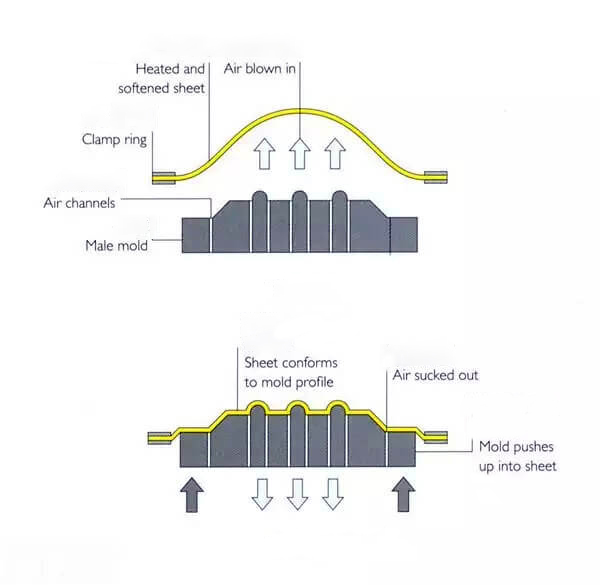
Specialize in Compression molds

Specialize in Compression molds
Thermoforming tooling plays a critical role in the production of thermoformed products. This article examines the types of tooling used in thermoforming, their applications, benefits, and key considerations for achieving optimal production results. Whether you're in the automotive, packaging, or consumer goods industries, understanding thermoforming tooling is essential to improving efficiency, reducing costs, and maintaining product quality.
Thermoforming tooling refers to the molds and dies used in the thermoforming process, in which plastic sheets are heated to a pliable state and then formed into specific shapes by applying pressure. The tooling serves as the mold that determines the final shape and quality of the thermoformed product.
There are two main categories of thermoforming tooling:

Thermoforming tooling varies greatly depending on the complexity and requirements of the final product. The most common types include:
Vacuum forming is the most widely used thermoforming technique in which a heated sheet of plastic is placed over a mold and a vacuum is applied to force the material against the surface of the mold. This type of tooling is ideal for producing large, flat parts such as trays, clamshell packaging, and plastic covers.
Pressure forming involves applying both heat and pressure to the plastic sheet, resulting in more intricate details and thicker walls than vacuum forming. This type of tooling is used to produce parts that require higher quality and precision.
In this process, a plug (or plug-assist tool) is used to push the heated plastic sheet into a mold, which helps achieve better material distribution and uniform wall thickness. This type of tooling is used to produce parts with deeper draws and intricate shapes.
Twin-sheet thermoforming involves heating two separate sheets of plastic, then simultaneously forming and fusing them together. This type of tooling is ideal for applications requiring structural rigidity and additional features such as double-wall parts.
Thermoforming tooling is used in a variety of industries to produce a wide range of products. The versatility of thermoforming allows it to serve industries such as automotive, packaging, medical, consumer goods and more. Below are some of the major applications:
Thermoforming tooling is used extensively in the automotive industry to produce lightweight, durable, and aesthetically pleasing components. Parts such as door panels, bumpers, instrument panels and trim are commonly thermoformed. The ability to produce large, complex parts with minimal waste is a significant advantage in automotive manufacturing.
One of the most common applications for thermoforming is in packaging. Thermoformed trays, clamshells, blister packs, and containers are all produced using thermoforming tooling. These products are lightweight, cost-effective, and customizable, making them ideal for packaging food, electronics, medical devices, and more.
Thermoforming tooling is also widely used in the production of consumer goods such as plastic containers, appliances, and products with complex shapes. The ability to create detailed and lightweight parts with thermoforming tooling is a huge advantage for consumer goods manufacturers.
In the medical field, thermoformed products must meet stringent standards for safety and precision. Thermoform tooling is used to produce sterile packaging, trays and specialized medical parts. Precision tooling ensures the highest standards of hygiene, safety and product performance.
Thermoformed signs, displays and graphics are produced with thermoforming tooling. The ability to produce large, intricate designs with high visual impact makes thermoforming a popular choice for the signage industry.
Using the right thermoforming tooling can offer manufacturers a wide range of benefits, including
Thermoforming tooling is generally less expensive than other molding methods such as injection molding or rotational molding. The molds used in thermoforming are also easier to maintain, making it a more affordable option for mass production, especially for large parts or low-volume runs.
Thermoforming can achieve high levels of production efficiency. The process is faster than other molding techniques, especially for simple to moderately complex parts. Once the tooling is developed, the manufacturing process can be highly automated, significantly reducing production time.
Thermoforming tooling allows for a high degree of design flexibility, enabling the creation of intricate and detailed designs. It also offers flexibility in material selection, as the tooling can be adapted to form different types of plastic materials.
Thermoformed products tend to be lightweight, which is beneficial in industries such as automotive and packaging. The ability to reduce weight without compromising strength can result in cost savings and improved product performance, especially in the automotive sector.
The thermoforming process often produces minimal material waste compared to other manufacturing processes. The plastic sheets used in thermoforming can be easily recycled, contributing to more sustainable manufacturing practices. This is in line with global trends to reduce waste and improve resource efficiency.
While thermoforming tooling offers numerous benefits, there are a few key considerations to ensure optimal performance:
Choosing the right material for the mold is critical to ensuring the quality and longevity of the mold. Factors such as material thickness, type of plastic, and the desired result should be considered. Common materials for thermoforming tooling include aluminum, steel, and composites, each offering different advantages depending on the application.
Tooling design plays a critical role in the quality of the final product. Proper tooling design can reduce cycle times, increase precision and improve part strength. It is important to work with experienced mold designers to ensure that molds are optimized for the specific product being manufactured.
Regular maintenance of thermoforming tooling is essential to prevent defects and maintain high production standards. Proper cleaning, lubrication, and inspection of the molds will ensure their longevity and reliability in production.
For more information on thermoforming tooling, contact MDC Mould or visit our website to explore our comprehensive range of tooling solutions.
Contact US
Email: master@zjmdc.com
Tel: +86 576 84616076
Fax: +86 576 84616079
Mobile: +86 13906573507(Mr. Wang)
Address: No.116 mochuang road, Huangyan Xinqian street,Taizhou,Zhejiang,China